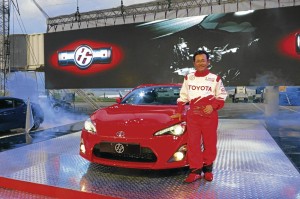Action on the tarmac with the Toyota 86

TOYOTA Motor Philippines Corp. Michinobu Sugata dons a racing suit as he presents the FT86 Monday at the formal launch in Subic. PHOTO BY JEANETTE IPAPO-TUASON
The sky was gray and cloudy, rain was pouring and a strong wind was blowing at the Subic International Airport last Saturday afternoon, but the threat of Typhoon “Butchoy” didn’t dampen the excitement and enthusiasm on the ground. There were five reasons for the eager anticipation: five new Toyota 86 sports cars were parked in the hangar, four of which would be driven around the tarmac by drift motor sport champion David Feliciano and three of his crew for a video to be shown during the car’s launch. The fifth, a white TRD Aero, was off limits. If you don’t know it yet, the 86 is one of the most anticipated and talked-about new cars in the world of wheels.
The Inquirer Motoring team was there, too, not only to take a sneak peek at the 86, but also to test-drive Toyota’s first new sports car 13 years after the Supra was phased out. The 86 is like no other Toyota because it was co-developed with Subaru, is powered by a horizontally opposed boxer engine that is Subaru’s trademark but has Toyota’s direct injection technology, is rear-wheel-drive and has two doors. But above all, the 86 is like no other Toyota because it promises fun, unlike the sedate sedans and people carriers that Japan’s No. 1 car manufacturer has been churning out.
No wonder David Feliciano et al. were impressed with the 86. It is named after the AE86 Toyota Corolla of the 1980s that drift enthusiasts have been using over the years. Another nugget of historical info: the first car to have a boxer engine was not a Subaru, but the 1965 Toyota 800 coupe. Now, the Toyota 86 and the Subaru BRZ have the same 2.0-liter boxer engine.
Gripping. But back to the action with the drift experts. The wet, slippery tarmac was actually better than a dry surface for drifting as proven by the gripping (no pun intended) performance of Feliciano and his men. After their thrilling show, us spectators felt timid about taking the 86 out for a spin on the tarmac.
However, we couldn’t resist the sporty allure of the 86, with design cues from Maserati and Ferrari in its haunches and front guards, low-slung exterior styling resembling the Toyota 2000 GT, dual exhaust pipes, 6-speed gearbox, butt-hugging and well-bolstered front seats, boy-racer red and silver highlights in the cockpit, chrome gauges and alloy pedals.
Article continues after this advertisementThe 2.0-liter, naturally aspirated, 16-valve, DOHC 4-cylinder gasoline boxer engine of the 86 with direct fuel injection produces 200 PS at 7,000 rpm and 205 Nm max torque at 6,400-6,600 rpm. The transmission is either a 6-speed automatic with paddle shifters or a 6-speed manual, both with electronic power steering. The unit I test-drove had a manual gear shift, which I found to my delight to be a short-throw stick that allowed quick, precise gear changes.
Article continues after this advertisementFaster. The tiny steering wheel, the smallest ever made by Toyota, was also delightful as it gave faster steering response and more feedback to my hands. Certainly, 200 PS peak output and 205 Nm max torque, aside from claimed acceleration of zero to 100 kph in 7.6 seconds isn’t exactly neck-snapping, but the intake and exhaust sounds filtered into the cabin by a built-in noise generator will create the impression that you’re going faster than you really are. Max power and torque are achieved at very high revs—at 7,000 rpm and 6,600 rpm respectively—which means that the engine sounds best above 4,000 rpm. On the tarmac, with these sound effects, I thought that I was driving fast until the electronic speed readout indicated that I was only doing 107 kph.
Boxer technology, with pistons pumping from side to side instead of up and down, allows the engine to be placed lower down and farther back for better weight distribution. The 86’s front/rear weight distribution is 53:47. This, together with the low center of gravity comparable with that of the Porsche Cayenne and Nissan GT-R, plus the rear-drive system, results in a 0:27 coefficient of drag and greater stability on the road.
Stability. The 86’s safety features, aside from the usual ABS, six or more airbags, wireless door lock with smart entry and push-start system, and ventilated disc brakes front and rear, include a front performance rod, stabilizers front and rear and Vehicle Stability Control. The problem last Saturday was that when I took the wheel of the red 86, no one told me where the Vehicle Stability Control switch was and whether it was on or off.
When I drove around the wet, slippery tarmac, the rear end sometimes fish-tailed and it then appeared that I was losing control. But the 86 with its boxer engine and low center of gravity is built and engineered to stick to earth whether on the road or on the track, to remain composed and well-balanced with just a hint of being tail-happy. So apart from sliding a bit here and there in the wet, it never really lost its poise and I was always in control. And always in awe and admiration of the 86.
For driving enthusiasts looking for an affordable sports car, the good news is that the 86 with manual tranny (the more fun choice) will cost only around P1.4 million while the automatic will sell for around P1.650 million. The bad news is that Toyota Motor Philippines expects an allocation of only 80 units or less this year.